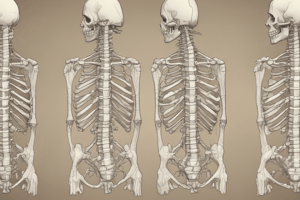Podcast
Questions and Answers
How many vertebrae are found in the adult human vertebral column?
How many vertebrae are found in the adult human vertebral column?
- 26 (correct)
- 34
- 30
- 32
Which type of vertebrae is not present in the adult vertebral column?
Which type of vertebrae is not present in the adult vertebral column?
- Cervical
- Coccygeal (correct)
- Lumbar
- Sacral
What is the main function of the axis (C2) vertebra?
What is the main function of the axis (C2) vertebra?
- Support the skull
- Serve as attachment for ribs
- Facilitate head rotation (correct)
- Protect the spinal cord
Which of the following categories includes the most vertebrae?
Which of the following categories includes the most vertebrae?
What structure is absent in the atlas (C1) vertebra?
What structure is absent in the atlas (C1) vertebra?
At what age do the vertebrae in the sacral region typically fuse in adults?
At what age do the vertebrae in the sacral region typically fuse in adults?
Which part of the vertebrae is responsible for articulating with adjacent vertebrae?
Which part of the vertebrae is responsible for articulating with adjacent vertebrae?
How many lumbar vertebrae are present in the typical adult human?
How many lumbar vertebrae are present in the typical adult human?
What characteristic is unique to cervical vertebrae compared to thoracic and lumbar vertebrae?
What characteristic is unique to cervical vertebrae compared to thoracic and lumbar vertebrae?
Which of the following accurately describes lumbar vertebrae?
Which of the following accurately describes lumbar vertebrae?
What type of rib is described as having no direct attachment to the sternum?
What type of rib is described as having no direct attachment to the sternum?
Which characteristic differentiates thoracic vertebrae from cervical and lumbar vertebrae?
Which characteristic differentiates thoracic vertebrae from cervical and lumbar vertebrae?
What is the structural composition of the coccyx?
What is the structural composition of the coccyx?
Which statement accurately describes the spinous process of lumbar vertebrae?
Which statement accurately describes the spinous process of lumbar vertebrae?
What connects the sacral vertebrae to the iliac bones?
What connects the sacral vertebrae to the iliac bones?
Which vertebrae are identified as the vertebral prominens?
Which vertebrae are identified as the vertebral prominens?
Which type of rib is directly attached to the sternum by costal cartilage?
Which type of rib is directly attached to the sternum by costal cartilage?
How many pairs of false ribs are there?
How many pairs of false ribs are there?
What do floating ribs lack that distinguishes them from true and false ribs?
What do floating ribs lack that distinguishes them from true and false ribs?
Which structure is NOT part of the scapula?
Which structure is NOT part of the scapula?
The anatomical neck of the humerus is located between which two structures?
The anatomical neck of the humerus is located between which two structures?
Which of the following is a function of costal cartilage?
Which of the following is a function of costal cartilage?
What is the name of the process located at the inferior end of the sternum?
What is the name of the process located at the inferior end of the sternum?
Which part of the humerus is located anteriorly and serves to accommodate the ulna?
Which part of the humerus is located anteriorly and serves to accommodate the ulna?
Which fossa on the scapula is located above the spine?
Which fossa on the scapula is located above the spine?
Which bone features the greater and lesser tuberosities?
Which bone features the greater and lesser tuberosities?
Flashcards are hidden until you start studying
Study Notes
Vertebral Column Anatomy
- Comprises 32-34 bones in infants; 26 bones in adults.
- Divided into five categories:
- Cervical: 7 vertebrae
- Thoracic: 12 vertebrae
- Lumbar: 5 vertebrae
- Sacral: 5 fused in adults (fusing occurs by ages 25-30)
- Coccyx: 3 to 5 fused (fusing occurs by ages 26-32).
Cervical Vertebrae
- C1 (Atlas): Modified to articulate with occipital condyles; lacks spinous process and body.
- C2 (Axis): Acts as a pivot for head rotation; features a tooth-like odontoid process (dens).
- C3-C6: Smallest vertebrae; contain transverse foramina for vertebral artery passage; possess bifid spinous processes.
- C7 (Vertebral Prominens): Easily palpable; lacks bifid spine.
Thoracic Vertebrae
- T1-T12: Larger than cervical but smaller than lumbar.
- Have elongated transverse processes for rib articulation; spinous processes point downward.
Lumbar Vertebrae
- L1-L5: Largest and strongest individual vertebrae.
- Spinous processes project straight out; generally have blunt, large processes.
Sacral Vertebrae
- Comprise 5 fused vertebrae; sacral nerves exit through sacral foramina.
- The sacrum is wedged between the iliac bones, forming the sacroiliac joint.
Coccyx
- Composed of 3 to 5 fused vertebrae; known as the tailbone.
Ribs
- True Ribs: 7 pairs, attach directly to the sternum via costal cartilage.
- False Ribs: 3 pairs, attach to the costal cartilage of the 7th rib.
- Floating Ribs: 2 pairs, do not attach anteriorly.
Sternum Structure
- Features include the manubrium, body, sternal angle, and xiphoid process.
Clavicle Structure
- Consists of sternal end and acromial end.
Scapula
- Posterior View: Includes the acromion process, spine, medial and lateral borders, superior angle, and inferior angle.
- Lateral View: Contains the coracoid process, glenoid fossa, supraglenoid and infraglenoid tubercles.
Humerus
- General structures include the head, greater and lesser tuberosities, anatomical and surgical necks, deltoid tuberosity, and various fossae (coronoid, radial, olecranon).
Studying That Suits You
Use AI to generate personalized quizzes and flashcards to suit your learning preferences.




